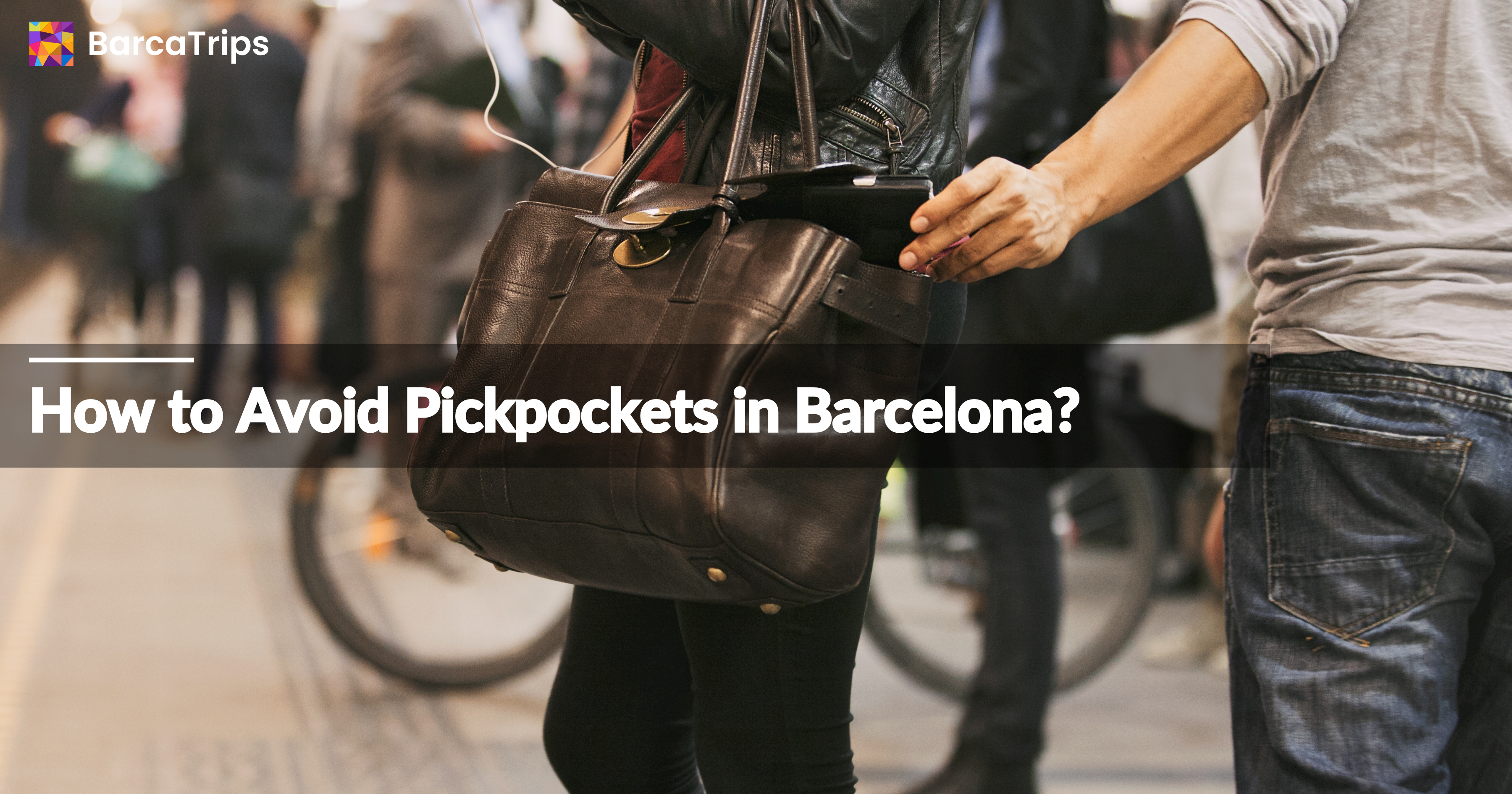The Architecture of Casa Batlló by Antoni Gaudí

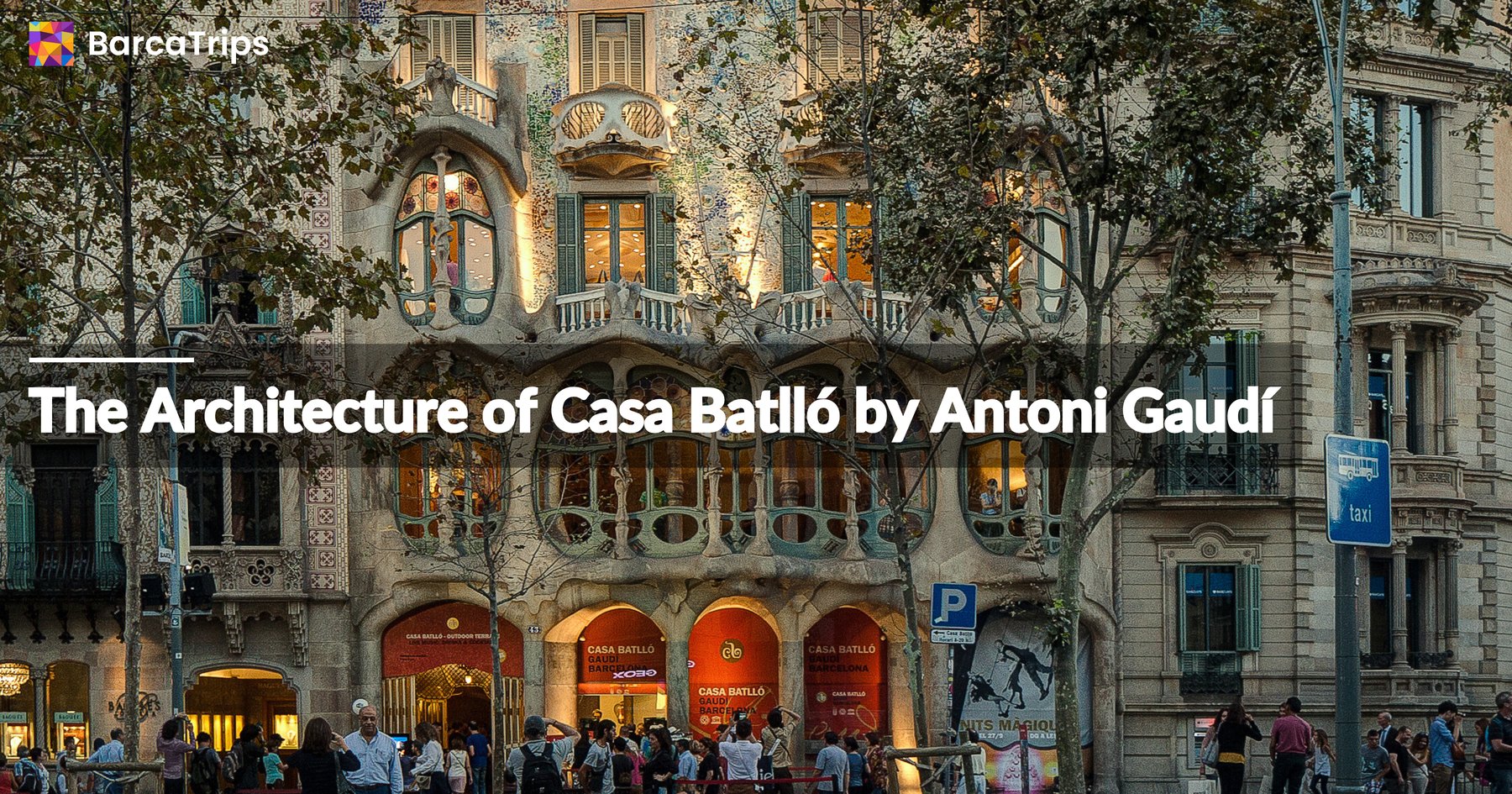
Casa Batlló's architecture is a marvel that defies conventional design. Crafted by the visionary Antoni Gaudí, this gem enchants with its vibrant mosaic façade, organic forms, and a whimsical, almost surreal design.
Its uniqueness is a testament to Gaudí's creative freedom and desire to create a symbol that stands out.
Its beauty is a sight that captivates all. Every curve and shade is a tribute to nature, making it one of the most photographed buildings in the city.
Whether you're exploring the dragon-like roof or the stained-glass windows, Casa Batlló is a masterpiece that ignites imagination at every corner.
Quick Facts about Casa Batlló
| Architect | Year | Style | Location | Nicknames | Status |
|---|---|---|---|---|---|
| Antoni Gaudí | redesigned in 1904-1906 | Catalan art Noveau | Passeign the Gràcia | House of bones/dragons | UNESCO word heritage 2005 |
Casa Batllós' unique architecture is due to many distinctive factors. As a young architect, Gaudí had a vision to renew local urban sites from the post-war simple architecture to build more complex buildings that encapsulate the essence of Catalan culture through his eyes.
His vision came through when, on one of his projects to demolish the Batlló family house, Josep Batlló gave him complete creative control over the project. Gaudí, competing for urban awards from the city council, created one of Barcelona's most memorable sights. He was part of the Cerdà Plan, which aimed to modernize the city.
Even though they were not much appreciated at the time, these buildings are now the pride of locals.
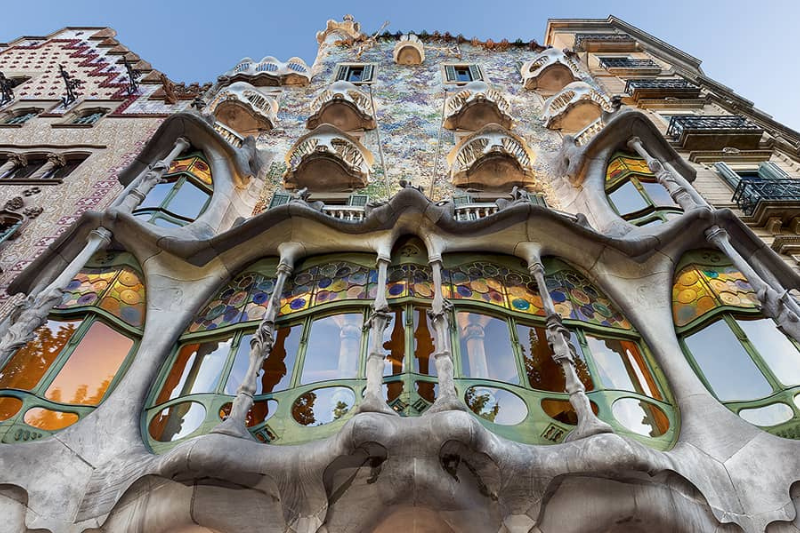
A Façade
The façade of Casa Batlló is a tribute to the Catalan legend of Saint George, the knight who defeated a dragon to save a princess, and from the dragon's blood, a rose bloomed. Inspired by this tale and the organic forms of local nature, Gaudí brought the story to life in architectural form, transforming the building into a fairytale masterpiece that is now one of the most photographed landmarks in Barcelona.
Undulating surface made of stone, glass, and ceramic trencadís: symbolizes the fluidity of nature and the ever-moving, living essence of the building.
Balconies shaped like masks: evoke both mystery and transformation; some see skulls, others see flowers, suggesting beauty emerging from danger.
Bone-shaped columns supporting the main floor: represent the remains of the dragon or the bones of its victims, enhancing the building's mythical undertone.
A roof that resembles a dragon's back, covered in iridescent ceramic tiles: references the slain beast, shimmering with life and color.
A tower topped with a cross: possibly symbolizes Saint George's sword driven into the dragon's spine in the final act of triumph.
Light, Color, and Movement Inside

Inside Casa Batlló, Gaudí masterfully used light, color, and movement to create a living, breathing space that stimulates the senses.
Natural light flows through the central skylight and light well, bouncing off tiles and glass to illuminate every corner.
He used a gradient of blue tiles that deepen in color with height to balance light distribution, enhancing the feeling of harmony.
Curved lines and flowing forms throughout the interior mimic waves and organic movement, creating a dynamic, almost dreamlike atmosphere.
Beyond beauty, Gaudí's choices were functional and sustainable, maximizing natural light, ventilation, and energy efficiency long before it was common practice.
Noble Floor
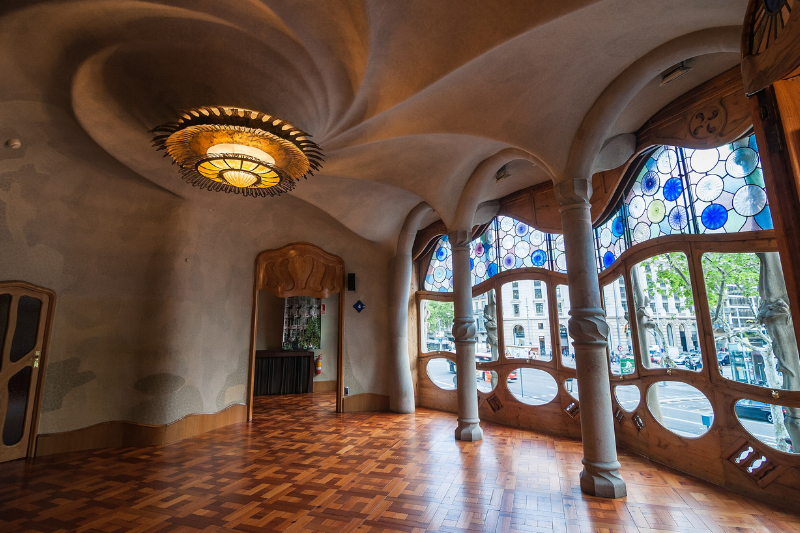
The noble floor, or "planta noble" in Spanish, was the main living area of the batlló family, richly decorated with marine motifs, as if you're in a fantasy world.
The main room features large stained glass windows and wavy walls. It has a mushroom-shaped fireplace and a dragon-like wooden staircase leading to this floor. A tiled courtyard lets in light, brightening the space.
The design may symbolize the inside of a dragon, linking to the Catalan legend of Saint George.
The Atriums (Lightwells)
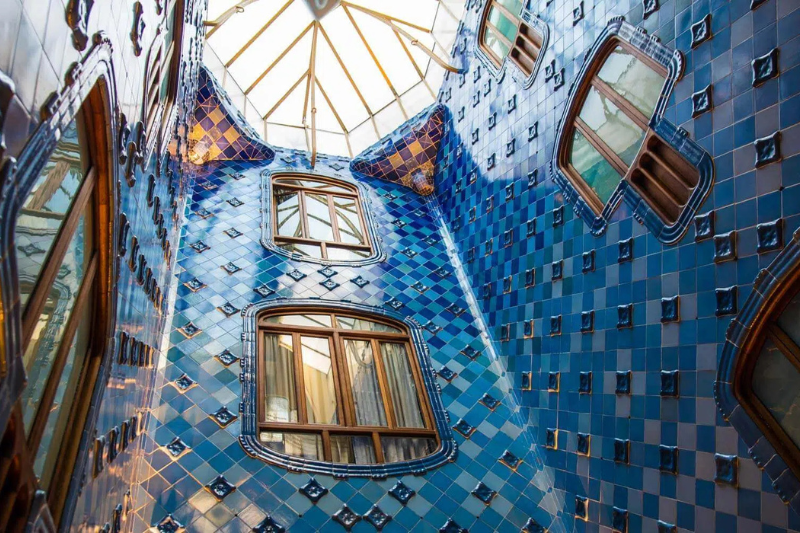
The atrium of Casa Batlló is the central light well that brings natural light and fresh air to the inner rooms of the building.
Gaudí redesigned it with blue and white tiles that get darker as they go higher, creating a balanced light effect from top to bottom.
Windows are larger on the lower floors and smaller at the top to control how light spreads.
He also added wooden slats and glass panels to improve ventilation and brightness.
The atrium is both functional and beautiful, showing Gaudí's genius for blending design with nature.
The Loft
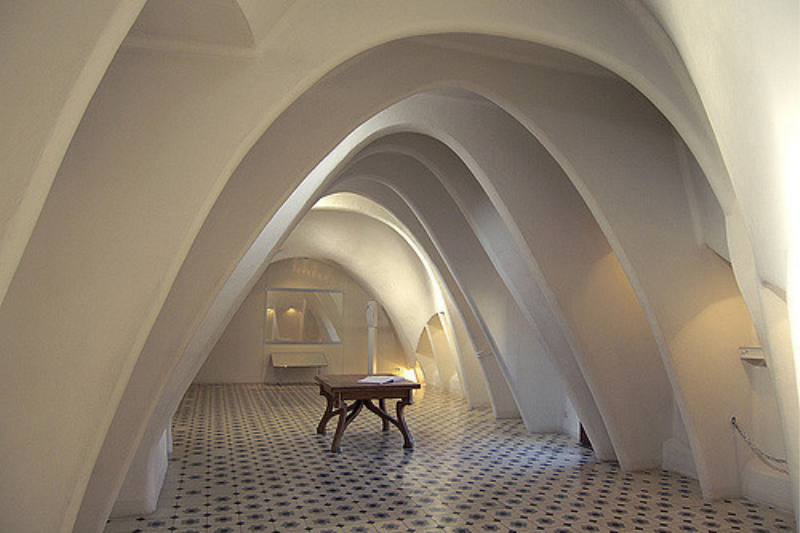
Once used as a service area, the loft is now a beautiful and peaceful space defined by 60 white catenary arches, giving it the look of a ribcage. Its simple, curved design feels both minimalist and Mediterranean. The space is calm and bright, a striking contrast to the colorful areas above. Gaudí used form and function together, turning a utility area into art. It's one of the building's most surprising features.
The Roof
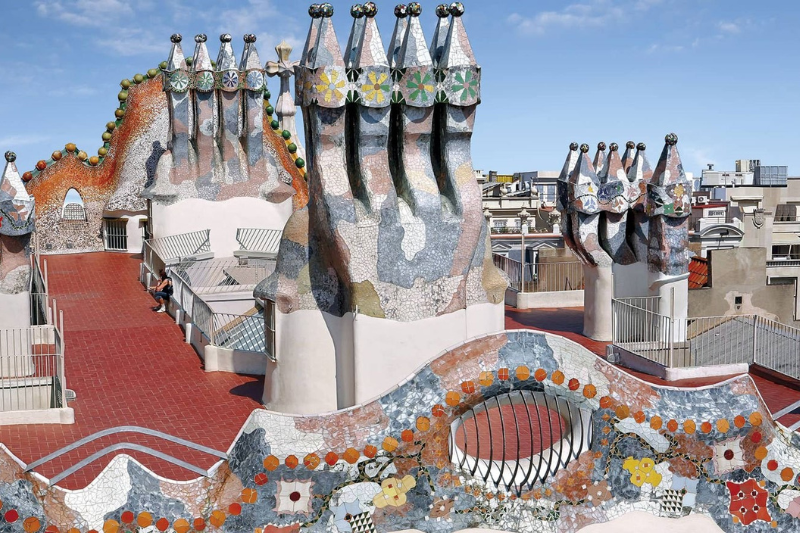
The roof of Casa Batlló looks like the back of a dragon, with curved lines and shiny ceramic tiles in changing colors. Gaudí designed the chimneys in tilted groups to prevent wind from blowing smoke back inside. These chimneys are sculptural and bold, adding motion and texture to the skyline. The whole roof feels alive, like a creature resting on top of the building. It's one of the most photographed parts of Casa Batlló.
What Materials Were Used?
Gaudí used a mix of creative and traditional materials to bring Casa Batlló to life. The façade is covered in colorful pieces of recycled glass and ceramic. Flowing stone shapes were sculpted from Montjuïc sandstone, while the balconies are made from cast iron. Stained glass windows shift in tone depending on the light. Every material was chosen for both beauty and purpose.
Restorations of Casa Batlló
Thanks to expert restorations, Casa Batlló has kept its original magic alive. Craftsmen used careful, archaeological techniques to recover lost details. Over five different materials, stone, iron, ceramic, glass, and wood, were cleaned and repaired. The 2021 restoration received a Special Mention at the European Heritage Awards. These efforts make sure Gaudí's vision continues to inspire visitors.
Is It Worth It?
Casa Batlló is one of the most unique buildings in the world, where every part tells a story through shape, light, and color. Even from the outside, it captures the imagination with its dreamlike design. Inside, Gaudí's attention to detail and creativity are everywhere. Whether you explore every room or admire it from the street, it's a one-of-a-kind masterpiece. A visit offers something magical for everyone.
FAQs
What architectural style is Casa Batlló?
Casa Batllós architectural style is Catalan modernism.
How is Casa Batlló different from other Gaudí buildings?
Casa Batlló differs from other Gaudí buildings due to its functionality and sustainability. Since other buildings at the time were not popularly constructed with this in mind as much.
What is the significance of the colors on Casa Batlló's façade?
The significance of the colors of Casa Batllós façade is the Catalan Mediterranean marine life.
All the different shapes and tones are carefully selected and placed to mimic the reflection the sun's light gives to the water, imitating movement.
What inspired Gaudí's design of Casa Batlló?
What inspired Gaudís design of Casa Batlló is Catalan tales and Mediterranean marine life.
Is Casa Batlló part of the Block of Discord?
Yes, Casa Batlló is part of the Block of Discord.
